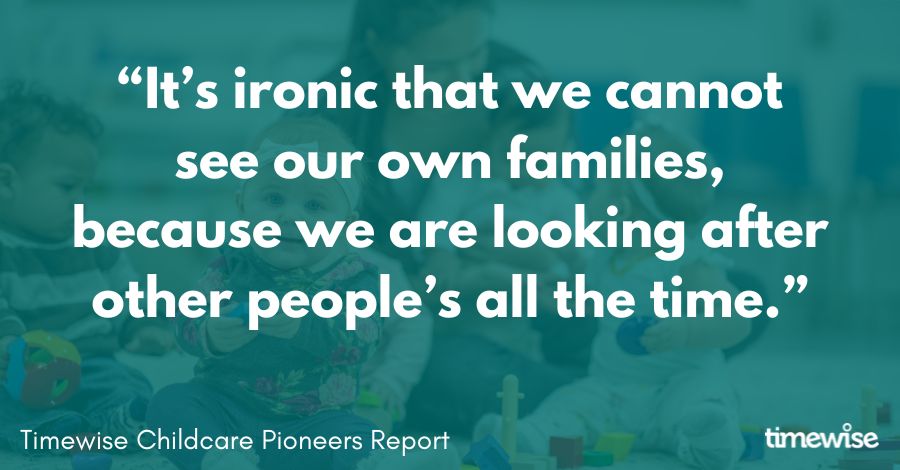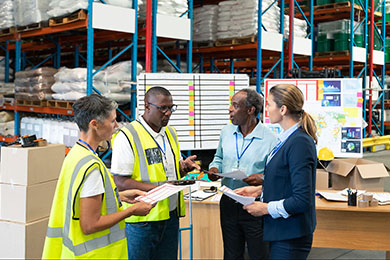

We brought employers from different sectors together to discuss how to support more young people into secure work with greater choice, autonomy and control.
By Tess Lanning, Director of Programmes
The next 12-18 months present a critical opportunity to improve employment outcomes for young people, as the government introduces a range of initiatives to tackle a rise in worklessness and insecurity.
As well as an increase in the age young people will be able to claim health-related benefits, this includes initiatives to improve the quality of jobs available. A new Youth Guarantee commits to providing decent training, apprenticeship and job opportunities for 18 to 21 year olds, while the Employment Rights Bill seeks to tackle high levels of low pay and insecurity in the economy.
Job insecurity disproportionately affects young people. Government statistics show that one in eight young workers are on a zero-hour contract, compared to less than one in 40 older workers, and young people are more likely to work volatile and variable work schedule patterns. Research has shown this is not only bad for early career job prospects – but can have a lifelong negative impact on employment, earnings and health outcomes (see Paul Gregg’s 2024 thought paper on future policy and Wen-Gui Han’s research article in to the effects of employment patterns on health in the US).
Government action to tackle these issues is therefore to be welcomed. But will employers engage with these initiatives? And if so, will young people see the benefits?
In June 2025, Timewise and Youth Futures Foundation gathered with employers from diverse sectors to find out.
Employers highlighted the focus on securing employees that can ‘hit the ground running’ in the context of rising financial pressures, combined with a reliance on tried-and-tested recruitment, selection and induction methods that favour older and more experienced workers.
Critically, they felt that there was a mismatch between dominant workplace cultures and the values, needs and expectations of younger workers – particularly in frontline sectors, where employers were finding it difficult to provide greater stability, security and flexibility at work. Many were struggling with skills gaps and vacancies as a result.
Employers had ideas for how to tackle these issues – from changes to hiring practices, management training, and more visible information about pay, progression and flexible working policies, to the creation of employee forums to co-design and support changes that improve long-term employment and health prospects for young people.
But they also highlighted the need for more support and evidence to inform good practice – particularly on issues affecting job security, such as scheduling practices and shift patterns. Without this, the new legislation may fail to hit the mark for young people.
Get in touch to understand how you can implement or inform good practice in these areas: info@timewise.co.uk
Published July 2025

By Dr Sarah Dauncey, Head of Partnerships and Insight, Timewise
We’ve been listening to workers in site-based roles over recent months in a series of focus groups, supported by Trust for London, to understand their views on flexible working and their experience of it in their workplace. Insights gained through these conversations are vital to inform our activity with employers and recommendations to drive positive change. There is now mounting evidence showing that control over working pattern is an important element of job quality, contributing to people’s sense of job satisfaction and wellbeing. It’s associated with healthy work.
And yet in spite of this evidence, there are millions of workers who not only have no control over their place of work but have minimal or no control over their schedules. The majority of workers (60%) are site-based and in customer facing or operational roles that couldn’t easily be worked from home. This is a feature of industry but also of job role and level of seniority. To put it simply, managers are more likely to get the option to work some of their time at home and to be able to flex their working hours whereas lower-paid workers have less choice. Their place and pattern of work is often fixed.
Recent Timewise research highlighted this ‘two-tier’ workforce, finding that almost a third of the workforce miss out on the benefits to health and work-life balance associated with flexible work.
The participants we engaged in our research represent a large part of the workforce. They worked in roles in construction, retail, health and transport. They recognised that flexibility was expected of them and was a requirement to get a job and keep it. They saw a clear distinction between “having” flexibility and “being” flexible. Their experience was that flexibility was all on them and wasn’t extended to them in return. One participant clearly articulated the impact of this: “Always being expected to be flexible can make you feel undervalued. It makes you feel your activities aren’t important.”
While their employers didn’t offer them any flexibility, they were very aware of it and of the difference it might make to their lives. This centred on having some sort of time-based flexibility to adjust start-finish times or condense or reduce working hours. Their understanding of what might be possible came through comparison with others working in different roles within their organisation or with friends and family working in entirely different jobs. They had a strong sense that “things could be different”. “Change can happen. The roster can change.”
The workers we spoke to felt trapped in systems that harmed their work-life balance. Parents with caring responsibilities described being placed in impossible situations at times – rigid patterns meant they were often unable to meet the needs of their children, creating a sense of guilt. Their awareness of the possibilities of organising work differently intensified their sense of frustration. They regarded their managers as stuck in “old school” ways, led by a fear of risk and a sense that “this is how things are always done.” The reluctance among managers to pursue change and explore alternative ways of working further contributed to workers’ low sense of worth. Systems and processes could change, but it’s too much of a “hassle” to do so.
This experience of inflexibility contributed to participants’ sense that they had poor work-life balance while also exposing some managers’ reluctance to give time and thought to workers’ circumstances beyond work. “I would rather take flexible working over a pay rise. It would make me a happier person.”
Participants recognised the impact of flexibility on their work-life balance, but also on their productivity. “We are all being held back by old-fashioned attitudes to work.” There was an overwhelming sense of lost potential resulting from working in contexts where they felt devalued and not fully trusted to work more autonomously.
When thinking more broadly about job quality and the elements of it, flexibility was seen as key. People want it, think that it’s possible and feel that they’re devalued through the lack of it. Their sense that it could be introduced with relatively few adjustments and low levels of risk just intensified their sense of not being worth the effort. When factoring in participants’ views that they would be more productive and loyal if trusted more and given flexible options. This is definitely an area for employers to reflect on given the level of emphasis on improving workplace performance and productivity in the current economic climate.
Our conversations highlighted the level of frustration experienced by workers resulting from a lack of flexibility and the need for workplace innovation for a complex of reasons: inclusion and belonging, work-life support, wellbeing and productivity. They also show that for reforms to be effective they need to be driven by an empathetic management approach.
When we asked our participants to “think big” and consider the sort of changes they would like to see in their workplace to improve their worker experience in the future and enhance their work-life balance, what was striking was the level of agreement. What they most wanted to see was more empathetic managers who considered their individual circumstances and their lives beyond work. They felt that once this was in place, flexibility would ensue.
These insights are critically important for employers and policymakers focusing on flexibility and how to make it work for all. Empathetic management shouldn’t have to be a recommendation for our workplaces, it should be a given. Yet it isn’t and too often it’s the primary barrier to flexibility being introduced or implemented effectively. This chimes with evidence found by CMI on the harm caused by bad managers, to individual employees and to organisations’ productivity. One in four people in the UK workforce holds a management role but only 27% of workers describe their manager as ‘highly effective’. This has implications for retention as manager behaviour has a sizeable impact on the likelihood of employees leaving their job.
Increased investment in training managers by employers is required to ensure flexibility is introduced and is working effectively to support employees’ work-life balance, performance and experience of job satisfaction. Such training would lead to wins for employees, but also for organisations looking to reduce staff turnover and sickness absence and increase productivity. Things can and should be different.
Published February 2025
Access to part-time and flexible working is highly valued and far more easily available to those in office based and higher earning jobs. Site-based and shift-based workers, such as medical staff, transport workers, nurses, cleaners, retail assistants and construction workers, who all make up our everyday economy, typically have little or no flexibility in their roles, resulting in a ‘two-tier workforce’.
In partnership with abrdn Financial Fairness Trust, we set out to understand the potential for improving access to quality flexible work in four sectors that have a high proportion of shift and site-based work. Our research focused on frontline employees’ autonomy and control over the hours they work, and when and where they work, in health and care, retail, construction, and transport and logistics. We chose to focus on these sectors for the following reasons:
These four industries make up more than a third of UK employee jobs, so provided a representative test of whether and how the new legislation will improve work-life balance for site-based and shift-based workers.
We engaged with employers, workers, experts and sector representatives over 12 months, starting with in-depth industry research. This included a review of literature and interviews with HR and senior operational leads across the four sectors.
This was to understand:
Then we further tested and refined our findings with sector stakeholders to develop practical strategies to increase the adoption of flexible and secure work in their industries, taking into account the impact for employers, sector bodies and government.
We did this through a number of roundtable discussions with employers, trade unions and sector bodies, chaired by sector leaders including Danny Mortimer, Chief Executive of NHS Employers; Helen Dickinson OBE, Chief Executive of the British Retail Consortium; Kim Sides, Executive Director of BAM Construction; and Kevin Green, Chief People Officer at First Bus and Timewise Chair, as well as focus groups with lower-income workers in site-based roles.
It was clear that a different set of principles and ways of talking about how work is designed is needed to encourage frontline employers to be able to change the way that rosters and shift patterns are created. Our ‘Shift-Life Balance Model’ recognises that it’s key to understand the size and volume of work first of all, then consider employees’ input into their schedule, fair notice of shift patterns as well as regular work patterns.
A common vision for secure and flexible work in frontline sectors
Our engagement with employers, sector bodies and workers revealed that, with the right sectoral strategies, incentives and support, is it possible to implement flexible and secure work in frontline sectors of the economy. Insights from the industry panels suggested three building blocks for making progress on this good practice vision:
Whilst there are a few examples of excellent practice, there is still a long way to go to establish secure and flexible working cultures more broadly. Workers are concerned about flexibility that favours employers, but doesn’t give them any input, control or security themselves.
![Worker voices: Quote 1, They think that they give you flexibility then the company will get out of control. A domino effect. Quote 2, I wouldn't be brave enough to ask [for flexible working] for fear it might damage my career.](https://timewise.co.uk/wp-content/uploads/2025/01/Industry-Leaders-Infographic-worker-voices.jpg)
Our research revealed some complex barriers to realising flexible and predictable working models, including:
The core challenge is to drive the good practice by a small number of individual organisations towards a more cross-sector approach, mainstreaming predictable and flexible working cultures across industries.
Our research has shown that a stronger statutory framework alone will not produce the workplace culture, business and operational shifts needed to tackle ‘one-sided flexibility’ in favour of employers, particularly for those in shift or site-based roles in frontline sectors. We have identified two key weaknesses (detailed in the report) and believe that a sector-based approach is essential for real change to take place.
We have established a coalition of leading employers, sector bodies and union representatives who are calling for government to work in partnership with industry and workers to ensure legislative proposals in the Employment Rights Bill can be successfully implemented.
This is urgently needed to give workers in the ‘everyday economy’ greater control and predictability and to realise the government’s wider goals on workforce participation, reducing economic inactivity and achieving inclusive economic growth.
Four ‘sector guides’ are published alongside this report offering sector-specific recommendations for employers and sector bodies on improving access to flexible and predictable work for frontline employees.
Published January 2025

By Nicola Pease, Principal Consultant, Timewise
We can all agree that any functioning society needs an excellent system of early years and childcare provision. At present, our high quality early years educators are managing to provide a great service, but many are stressed, exhausted and have little to no work-life balance. In short, it’s an early years system on the edge.
While issues around pay and progression loom large with no immediate resolution in sight, let’s look to what we can fix. Building on recent successes in other shift-based, site-based sectors such as nursing, construction and retail, Timewise launched a report following an in-depth two-year project in the early years and childcare sector. Thanks to support from JPMorganChase we were able to partner with two leading childcare providers: the Early Years Alliance and the London Early Years Foundation, and get close to childcare staff, in settings.
We analysed the industry’s challenges and assessed its potential with regards to improving staff wellbeing through changes to working patterns. Sometimes, even the smallest changes can make an enormous difference. We conducted all our research and analysis whilst keeping the experiences of children and parents front of mind. If this is going to work: it has to work for everyone.
We held a packed event in Westminster, with support from the Early Education and Childcare Coalition, to launch our subsequent report, Building the early years and childcare workforce of the future, with early years providers, policymakers and local and national government representatives. We collaborated on ideas and sharing ‘what works’ at settings across the UK. All with the experience of children and quality of education and care, front and centre of our thinking. Read on, to find out more…
The early years sector is facing a perfect storm – the expansion of 30 hours funded childcare will require an additional 35,000 staff across the UK, yet 78% of providers in a recent survey said they are already struggling to attract people to a sector that is not competitive on pay or working conditions. 62% of the workforce earn less than the living wage, with pay rates similar to roles in retail and hospitality, that are arguably less physically and emotionally demanding – and sometimes offer more flexibility in terms of what shifts and hours people can work.
There is also an increasing number of pressures on our early years educators which is driving up their workload and making the job harder. For example a growth in the demand for longer-hours provision to meet the needs of parents and (as was raised numerous times at our event), a hugely increased number of children presenting with SEND. All this notches up the pressure gauge.
The research found that nearly two-thirds of staff in group-based settings have said they do not have good work-life balance.

Part-time work across the sector has fallen in the majority of settings since 2018-19 with flexible working options generally achieved through the use of casual, agency or bank staff.
Managers recognised the potential benefits of offering flexible working but were concerned about continuity of care, maintaining staff-child ratios, meeting training standards, ensuring fairness and managing team dynamics. As one person described life in a nursery, “It’s a constant jigsaw.”
At the roundtable we heard a clear call to value those working in Early Years more highly, recognising that, “It’s not just about numbers, it’s about ensuring those who care and educate are energised, valued and motivated to do so.” There was an acknowledgement that emotional resilience is key in a workplace that demands a high level of emotional investment in children’s development and needs. And a sense that there is a need to better balance the workloads and schedules of those in such an intense working environment, to better support physical, mental and emotional wellbeing.
Increasing access and opportunity for the sector is a challenge, but through the research and numerous examples of good practice, it was proven to be possible within the operating constraints of the sector – all with the voice of the child front and centre. Innovative work practices included split-shift patterns (read Ruth’s story on page 11 of the report) and recruiting lunchtime assistants (page 18 of the report), housekeepers or tea-time assistants who enable flexibility across the wider teams. As Neil Leitch, Chief Executive of the Early Years Alliance put it, “You have to be creative. Continuity is critical but that does not mean you need always to see the same person.”
And it can also be used to enhance an organisation’s management capabilities. As June O’Sullivan OBE, the Chief Executive of LEYF said, “We need to think creatively about flexibility, in its wider context. For example, think flexibly about how you think about succession planning. It can help planning the next steps for staff or an experienced manager phase their retirement slowly, while helping a new manager to build their skills and knowledge.”
At a national level, Timewise is calling for a workforce plan that includes flexible working as a key strategic pillar. We estimate that a recruitment drive based around part-time and flexible working could attract staff to fill the equivalent of 17,850 full-time vacancies. That’s half the 35,000 shortfall the UK currently faces, to meet the expansion of 30hrs/week funded support.
Locally, we need authorities to bring networks of childcare providers together to share learnings, consider challenges and how to overcome them by exploring innovative practices such as sharing of bank staff. There was real momentum at our event around this idea – clearly they have a real ‘binding’ role to play. And for childcare providers themselves, we need to see a shift away from an individualised request-response model of flexibility towards a more pro-active whole-setting approach that encourages creativity and innovation and enables staff input into working patterns. To support this, Timewise have created a series of toolkits and resources for managers, which can be found here.
There is no magic wand with which to fix the staff and people problems that the early years sector is facing. But creating good standards of flexible working, in an industry where 98% of employees are women, many of whom have their own caring responsibilities, is not just good business sense. It’s a way to improve wellbeing and the lives of those playing the vital role of nurturing our future generations.

By Dr Sarah Dauncey, Head of Partnerships and Insight, Timewise
Occupational segregation is a distinctive feature of the UK’s labour market and a driver of persistent inequality, in income and more widely in health. Workers from black and minoritised ethnic groups are overly represented in sectors where site-based, insecure and lower-paid work is prevalent. People from minoritised groups are also more likely to have a higher risk of developing long-term health conditions, which can affect people’s ability to work – especially in site-based and more physical roles. The pandemic exposed the health inequity arising from this, with minoritised ethnic groups disproportionately impacted because of the increased likelihood of being a frontline worker without the option to work from home.
These patterns are too often replicated within organisations, with people from minoritised ethnic groups overrepresented in lower-paid, site-based roles and functions like security, cleaning, catering and caretaking which typically have more limited access to flexible options. Where an organisational focus is on hybrid as a flexible option, disparities are intensified. Further, within their workplaces, workers from minoritised ethnicities can experience a sense of precarity or inferiority that restricts their confidence to challenge decision-makers and request reforms to conditions or working patterns for fear of losing their job.
This means that workers from black and minoritised communities are overall less likely to make the most of the workplace benefits that support better health. This includes the improved work-life balance that comes from better autonomy and flexibility. Unhealthy working conditions contribute to ill-health, and ill-health restricts people’s ability to work, creating a cycle that is increasingly difficult to overcome in the context of the rising cost of living.
It’s in the context of this structural inequality that Runnymede and Timewise established a partnership, with the support of Impact on Urban Health. We wanted to better understand the relationship between flexible working and organisational approaches to equality, diversity and inclusion, and how site-based workers from black and minoritised ethnic backgrounds perceive and experience flexible working.
More specifically, we wanted to find out how new ways of working supported or thwarted a sense of inclusion and belonging. This involved us speaking with two stakeholder groups in participating organisations, leaders of site-site based teams and their employees. We took an action-oriented approach to our research, ensuring that our insights drove meaningful change in participating organisations to address processes of exclusion.
The recent racist rioting, driven by a combination of routine, normalised discrimination – heated-up over recent years by mainstream politicians and media – has raised the stakes of our research and its implications for both workers and organisations. Our interviews were undertaken early in 2024. We heard workers’ sense of fear, their reluctance to ‘rock the boat’ and ask for working patterns that might challenge ‘ideal worker’ (i.e. white and male) stereotypes. People who have experienced, or are experiencing, racial trauma invariably have a different set of expectations about their level of input and control over their working pattern.
During the riots, we read harrowing accounts in the mainstream media of people facing physical and verbal threats because of their skin colour or religion, instilling fear among people from black and ethnic minorities across the country. While we welcomed hearing about employers who led with empathy and offered increased protections to their employees, including the opportunity to work from home if they were able to, we were mindful of the risks that site-based workers had to face. Yet again, people from black and ethnic backgrounds who worked in jobs with fixed locations faced greater exposure, this time, not to disease but to an outbreak of violent racism.
This disparity once again highlights the urgent need for employers of site-based staff to think both strategically and creatively about flexible options and how they can be used to value employees and provide work-life support. Our research shows how critically important it is for employers to be pro-active here, talking openly – to all – about available flexible options. Signposting them rather than expecting employees to have the confidence to ask for them.
Our study uncovered a complex of factors that posed barriers to site-based employees accessing flexible options. These broadly fall into three categories: operational, managerial and cultural. We found that employees’ race and ethnicity shaped their workplace interactions and expectations around working patterns and level of empowerment to pursue change. Here’s a summary of some of the main barriers that we identified.
These barriers, contributing to a diminished sense of autonomy, gave rise to frustration and personal stress among some employees – impacting on their sense of wellbeing and work-life balance. Moreover, participants recognised the connections between input and control over ways of working and organisational benefits, not just personal ones. They spoke of the gains that would flow from feeling trusted and more autonomous and empowered, such as higher levels of commitment and productivity.
Leaders participating in the research recognised the potential of flexible working to support inclusion priorities but were alert to the realities on the ground and the effect of variations in managers’ attitudes and approaches. They were aware of a disconnect between policy and practice leading to disparities. Organisational values and commitments weren’t being evenly role modelled and applied by managers.
So, what are the solutions to help employers navigate these challenges, improve their working cultures and deliver on equity and inclusion?
While localised initiatives need to be tailored and based on insights and measurement, we’re pleased to share some general insights from our research to drive meaningful organisation-wide action to address workplace inequalities and call out processes of exclusion.
We’re aware that further research is needed to deepen understanding of the complexity of the challenges facing minoritised ethnic workers over accessing flexible working options. The employers who partnered with us showed bravery and commitment to tackling systemic, structural and cultural challenges. They have sustained work ahead to deliver change, but a clear sense of where they’re heading and a route to get there with accountability in place. We’re delighted to say our peer researchers have now become pivotal to holding their organisations to account on delivery equity in access to flexible options, and ultimately better health.
Published November 2024

By Nicola Pease, Lead Principal Consultant
With the publication of the Employment Rights Bill, it was anticipated that the right to disconnect would be one of the raft of new rights for employees. However, it seems that this particular element of the legislation will instead be progressed through a Code of Practice. Although it will not become a statutory right, it remains a key pillar of Labour’s plan to Make Work Pay. In this article, we’ll explore what it’s likely to mean for employers and workers, and how best to prepare.
The government’s intention behind this new Code of Practice is to improve productivity and morale and promote work-life balance. The commitment is set out as follows:
“We will bring in the ‘right to switch off’, so working from home does not result in homes turning into 24/7 offices. We will follow similar models to those that are already in place in Ireland and Belgium, giving workers and employers the opportunity to have constructive conversations and work together on bespoke workplace policies or contractual terms that benefit both parties.“
Certainly, advancements in technology and the increase in hybrid working arrangements contribute to an ‘always on’ culture – where employees feel they are expected to be available and contactable outside of their working hours. A recent study by IOSH found an ‘epidemic’ of long working hours within the UK, and additionally found that 52% of respondents regularly check work related messages and emails outside of working hours, and 39% check and respond to work related messages whilst on annual leave.
This blurring of boundaries between work and outside-work life is what the government is seeking to address, and we at Timewise welcome the Code of Practice to help tackle what is a current and pressing wellbeing issue. Whilst some are concerned about a negative impact on productivity, we ascribe to the belief that well rested, healthy employees, who have protected time away from work, are likely to be more engaged and productive when they are working.
It appears the government are taking a similar approach to Ireland, which has an established a code of practice. This requires employers to come up with practical arrangements for guaranteeing periods when employees aren’t contacted and sets out obligations for time recording to demonstrate this.
Others including Australia, have also implemented their own formal right to disconnect from work, giving workers the right to refuse to monitor, read or respond to work-related communications without fear of dismissal or reprisals.
The language in Labour’s new deal suggests that they recognize that a ‘one size fits all’ approach won’t work on this – and that each workplace will be required to work out their own response to the new right, and how it can be implemented. In our experience, this seems sensible given the range of organisations and roles that will be impacted. Those organisations who genuinely engage their employees on this and work together to find the ‘win-win’, are the most likely to see positive shifts on organisational culture and behaviours. However, it’s unclear how employers are to be held accountable for upholding their responsibilities. We’d like to see the Code of Practice setting out clear requirements for monitoring and reporting to ensure it has an impact.
At Timewise, we support organisations of all shapes and sizes to innovate their working practices and design and implement new, flexible, ways of working. Our work focuses on finding the ‘sweet spot’ where the needs of the organisation and the needs of individuals can both be achieved. It involves being willing to look afresh at working practices and being willing to try something new. Co-designing solutions with managers and teams is our proven approach to achieving flexibility that works for all.
If you’re looking at your current workplace and can see that digital presenteeism and out-of-hours contact are regular occurrences, here are five things you can do:
The introduction of a Code of Practice provides an opportunity for managers and employees to revisit working patterns and arrangements, and ensure that they are working for individuals and enabling them to deliver productively in their roles. The right to switch off won’t automatically kick in at 5pm Monday to Friday in all cases – it’s about identifying what is reasonable and practical and ensuring the organisation’s culture and systems are set up to support this, and to harness the wellbeing and productivity benefits which will result.
Published October 2024
Changes in work: zero hours contracts
Changes in work: flexible working as a default Day One right

By Amy Butterworth, Consultancy Director
For too long, the UK has relied on the traditional 9-5, five-day-a-week working model, which we know no longer fits with modern lifestyles. While some industries, usually those with desk-based workers, have adopted flexible working with relative ease, spurred on by the pandemic, others with site-based or frontline workers have found it more challenging and risk being left behind. There is now a growing divide in the UK workforce between those who can work flexibly and those who cannot. Additionally, there is an increasing number of people out of work on sick leave, and employee burnout is on the rise too. With retention rates and employee wellbeing topping many leadership teams’ to-do lists, could flexible working be the answer?
Here at Timewise, we’ve long called for trialling different ways of working as we know the traditional 9-5 doesn’t work for everyone. That’s why we’re thrilled to be actively involved in the 4 Day Week campaign’s second pilot, which begins this Autumn. The second pilot has been expanded to give organisations greater opportunity to experiment with different kinds of flexibility, which aligns with the work we do, especially with front-line and site-based workers. Can the newly evolved four-day week trial pave the way for more flex, especially in traditionally hard-to-flex roles?
The first four-day week pilot saw 61 organisations move to a four-day week without a pay loss for workers. Organisations reduced working hours by an average of 6.6 hours to reach a 31.6-hour week and gave their employees one full day off a week, either on a universal or staggered basis.
The results led almost every company (92%) to continue with a four-day week, with many citing its positive effects on employee wellbeing, business performance and improved retention. While the initial pilot reaped encouraging results, it’s important to note that the majority of people involved were desk-based workers. From our experience, time-based flexibility can be challenging to manage and it’s unlikely this ‘one-size fits all’ approach will work for all organisation types and workers.
Which is why we’re thrilled the 4 Day Week campaign is evolving to give organisations the opportunity to try different kinds of flexibility. This could be shorter working weeks, flexible start and finish times, a nine-day fortnight, or compressed hours. As this is our sweet spot, we had to get involved and lend our knowledge and experience to the programme. We believe this new pilot will give organisations with ‘hard-to-flex’ roles the opportunity to innovate in a low-risk way as we know from our pilots in a range of sectors, including construction, nursing, retail and teaching. And we also know that changes to make flexible working more widely available can pay for themselves in just a few years through reduced sickness absences and improved staff retention.
The 4-Day Week campaign is an opportunity for organisations to get creative, especially those that have frontline or site-based workers, who have traditionally hard-to-flex roles. It comes at a time when we’re hearing of more organisations trialling new ways of working, which can only lead to more data and better decision-making as a result.
South Cambridgeshire District Council recently experimented with a shorter week for desk-based workers before expanding its trial to include refuse collection workers. Despite criticism, the Council continued with its plans, which saw changes to routes, collection days and extra staff. This has resulted in fewer sick days, less absenteeism, and better overall retention.
Another example is retailer Wickes, who we worked with to pilot a new approach to flexible working. The pilot made flexible working a reality for store managers, which had a knock-on effect on the company’s ability to attract and keep staff. It’s now being rolled out to more managerial roles.
We firmly believe that pilots are valuable. They allow organisations to test and develop innovative workplace solutions, learning and fine-tuning along the way, before committing to rolling out new ways of working, increasing the likelihood of success and sustainability. We have extensive experience in this area and will be sharing key learnings and watch-outs with pilot organisations.
Organisations of all types are encouraged to sign up for the six-month pilot, which begins in November. Throughout the pilot, organisations will benefit from support and guidance, tailored to their needs. The University of Cambridge, Boston College, and the Autonomy Institute will conduct an impact analysis and the results will be presented to the Government in Summer 2025.
This pilot is an exciting opportunity for organisations to innovate and implement flexible working arrangements that support their employees’ needs. The experiences and results from this pilot can pave the way for others too, especially in industries that are reluctant to flex. Timewise’s CEO Claire Campbell, said: “This is a great opportunity to trial something which will benefit worker health and retention. Whether you work in a warehouse, a care home or behind a desk – we foresee a fairer flexible future for all and the first employers to step forward for this trial, will be a part of that.”
Find out more about the 4 Day Week Campaign pilot.
Published August 2024

By Dr Sarah Dauncey, Head of Partnerships and Insight, Timewise
Since the pandemic, numerous studies have highlighted the benefits of hybrid and remote working for employees. Hybrid working models have been found to have positive impacts on workers, especially in relation to health and happiness. While it’s great to see this evidence showing the value of place-based flexibility, what about the millions of workers who can’t access it? The majority of the workforce (60%) are site-based and shouldn’t miss out on the advantages associated with having autonomy and control over working patterns, including improved health and work-life balance.
For too long, the UK workforce has been divided between those who can access flexibility and those who can’t. This divide was amplified through the pandemic, and we’re still reeling from the effects of this – with high levels of sickness absence and rising economic inactivity largely attributed to poor health.
For frontline and site-based workers, there has been limited coordinated action to redress workplace inequalities. And with the new government promising to make flexible working the default from day one, it’s critical we understand how to do this in site-based roles and build the evidence to incentivise employers to take action.
In 2022, we initiated a programme to address this inequity in access to flexible working by partnering with the Institute for Employment Studies and with the backing of Impact on Urban Health. We approached three employers who we knew were committed to taking their flexible working agenda forward, Guy’s and St Thomas’ NHS Foundation Trust, Sir Robert McAlpine and Wickes. Over the course of the programme, Timewise supported each employer to introduce greater flexibility into frontline roles and the Institute for Employment Studies tracked the effect of these interventions. We wanted to test whether good quality work would improve employee health and wellbeing, and lead to benefits for employers, such as improved retention.
The institute of Employment Studies led an independent evaluation of the work and found that flexibility gave rise to a number of positive outcomes.
But perhaps the best way to demonstrate the impact of the programme is through the voices of those involved:
A Store Manager from Wickes, said: “The trial has made me appreciate my job more, and (if possible) has made me even more loyal to Wickes, as I have the best work-life balance I have ever had in all the years I have been at Wickes.”
While a Quantity Surveyor from Sir Robert McAlpine, said: “If I hadn’t been given this opportunity, I think the conversation would have been about going part-time. I couldn’t cope with balancing childcare and a full-time job. Financially that would have had a very negative impact on me. I wouldn’t have been in a good place mentally and I probably wouldn’t be as productive.”
Through our programme and its evaluation, we’ve gained some valuable insights for other organisations looking to introduce flexibility for frontline and site-based employees.
For our participating organisations, there’s no going back to former ways of working. They’ve embraced the changes and are scaling up to ensure that everyone can benefit through increased input and control over their working pattern. For example, since participating in the programme, Wickes has widenened access to flexible options to all their store managers across the UK.
All three employers demonstrated that listening to employees and taking the initiative to increase flexible working opportunities – despite the operational challenges of doing so – delivers rewards. They are vanguards of flexible working in critical sectors, offering learnings for other organisations to benefit from.
Our programme provides much needed evidence to drive action among employers and improve workplace and health equity for frontline and site-based workers. Flexible working is not just an option for knowledge workers – it’s a way of working that should be and can be available to all.
Published July 2024

By Amy Butterworth, Consultancy Director
Employers are facing a mounting list of challenges, from skills and labour shortages to a tightening economy to adapting to changing workforce demographics, where 1 in 3 workers are now over the age of 50. However, not all employers recognise the importance of older workers or understand how to retain them.
Workers in their 50s and 60s are willing to continue working later, albeit flexibly and yet many employers are still reluctant to offer flexible working options. While those who embrace flexible working will maximise the benefits of multi-generational workforces and be the leading employers of the next decade – maximising the knowledge, skills and talents of all ages.
We know first-hand the importance and value of older workers because our organisations came together in 2023 to create inclusive workplaces. Timewise is a proud supporter of The Centre for Ageing Better’s (CFAB) Age-Friendly Employer Pledge, a nationwide programme for employers committed to improving work for people in their 50s and 60s, and is helping to deliver some of the training.
We’ve run three masterclasses for employers who are CFAB pledge signatories, focusing on designing flexible work, making the business case for flexible work for older workers and bringing about changes to organisational practices, behaviours and mindsets.
In the masterclasses, managers focus on their role in influencing the way older workers experience work and how flexible roles can help with organisational challenges. Employers from different sectors and sizes shared similar experiences about older workers, who tend to feel less comfortable asking for flexibility than younger colleagues but provide valuable skills and knowledge that need to be protected. They also discussed the challenges of leading teams in multi-generational workplaces and balancing the needs and demands of a diverse workforce.
Findings from CFAB’s State of Ageing Report 2023-24 showed that employment rates among older workers vastly differ between men and women, disabled and non-disabled people and different ethnic groups. We strongly believe that taking action as an age-friendly employer will confront ageism and contribute to a more equal workplace for all.
Taking small steps to proactively build inclusive workplace cultures, where managers feel empowered to support flexible working for older workers will strengthen organisations and ripple across other groups within the workforce.
Here’s our advice to help you develop an age-inclusive workplace culture…
Our final word? Don’t put age diversity on hold any longer. It has the potential to bring value to organisations, benefiting not just those in their 50s and 60s but all groups within the workforce positively. We’re seeing some employers taking steps to address this issue, but not enough. Embracing age and a multigenerational workforce can increase productivity, profitability and make employees feel happier and engaged, why wait?
Sign The Centre for Ageing Better’s Age-Friendly Employer Pledge and learn more about Timewise’s workshops and training, which can be tailored to your needs.
Published April 2024

By Dr Sarah Dauncey, Head of Partnerships and Insight, Timewise and Carol Sidney, Researcher, Runnymede Trust
The new legislation giving employees the right to request flexible working from Day One in their job – which comes into force on 6th April – is helpfully prompting action among some employers. They’re looking to get ahead and make flexible working a reality for their people. They aren’t sitting and waiting for the requests to come in but are proactively giving their employees more choice over when, where and how they work. They know this matters, both for the health and wellbeing of their workers and for the sustainability of their organisation. This work is increasingly important given evidence that some groups are less comfortable to have an informal conversation with their employer about their working pattern than others. And these groups are also more like to report that they would consider using the new rights to gain access to flexible working options.
For instance, one of the headline findings from Timewise’s Opinium survey of 4000 workers, A Question of Time, was the significant disparity between black and white respondents over the likelihood of reporting that they would consider taking advantage of this right in a new role (71% versus 48%). Notably, Timewise also found that workers from minoritised ethnic backgrounds reported feeling less comfortable than their white counterparts to talk with their employer about their working arrangements (37% versus 28%). The attractiveness of the new rights to workers from minoritised ethnic groups to pursue greater control over when, where or how they work indicates the need for proactive interventions by employers to address racial disparities in the workplace.
This is vital work given the evidence that some minoritised ethnic groups are more likely than white British people to report having a long-term health condition or poor health. Studies have shown that access to good quality flexible work can impact positively on health by improving people’s experience of work-life balance. Hence, granting workers from minoritised ethnic groups greater autonomy and control over their working patterns is a key mechanism to address health inequity.
Runnymede and Timewise are therefore delighted to work in partnership, supported by Impact on Urban Health, to delve deeper into the relationship between ethnicity, occupation and flexible working arrangements. How do these factors interreact and enable or disrupt the experience of inclusion and belonging in the workplace among people from minoritised ethnic groups? We’re collaborating with four employers and listening to their workers from minoritised ethnic backgrounds, along with managers and leaders of predominantly site-based teams and services, to better understand the challenges and identify possible solutions. Through our partnership, we’re empowering workers to play a part in creating more inclusive and healthier working environments and cultures.
Workers from minoritised ethnic groups are more likely to be in low-skilled insecure work with limited progression opportunities than their counterparts from white backgrounds. Occupational segregation is a feature of the UK’s labour market, with people from some ethnic groups clustered in sectors like hospitality, characterised by the high proportion of lower paid and insecure jobs that have limited access to place-based flexibility. But even in sectors where homeworking is more prevalent, recent research by Kent University and the TUC highlights the disparities in access to, and experiences of, home working by ethnicity. Their findings reinforce those of Timewise’ Opinium survey. They found that minoritised ethnic workers are less likely to feel comfortable asking for home-based options because of previous experiences of racial discrimination combined with negative attitudes towards homeworkers. ‘The flexible stigma’ – the belief that flexible workers are less productive and committed – and racism combine to intensify experiences of exclusion for minoritised ethnic groups.
Structural patterns of inequality (driven by factors of health, care, education and skills) are too often reproduced within organisations of all types and sizes. Typically, people from some minoritised ethnic groups are overrepresented in low-skilled, site-based roles and functions like security, cleaning, catering and caretaking with more limited access to flexible options. Where flexible working is seen as a ‘perk’ in addition to pay, disparities are amplified. Flexible working can become a racialised issue and cause or intensify experiences of exclusion.
In organisations that are sceptical of the benefits of flexible working, marginalised groups are more likely to conform to dominant expectations and avoid ‘rocking the boat’ by asking for adjustments to their working pattern. In organisations further along the journey to widen access to flexible options to all, regardless of job role, cultures and the mindsets of some individuals can block access. For instance, some organisations participating in the project report fewer requests for flexible working received from employees in site-based teams and services. In those services, there can be a sense among workers that flexible working just isn’t compatible with their role. ‘It’s not an option available to me’.
For certain, change is going to involve sustained and focused action by employers. It’s going to involve empowered individuals working hard to bring people onboard and transform working cultures and practices. It will require far more than making some adjustments to HR policy. And, if progress is too slow on this agenda, it could well be that employees take up the new rights and force a culture shift to try and make work work better for them.
We’re excited to have the opportunity to collaborate and learn from people and practices in a range of organisations to generate new insights to foster inclusive workplaces. We’ll be writing more soon to outline some of the barriers we’ve encountered, but also to showcase some of the inspiring activity that is already underway to implement flexible working more equitably and inclusively – making it the default way of working for everyone.
Published April 2024